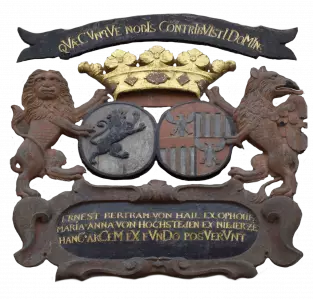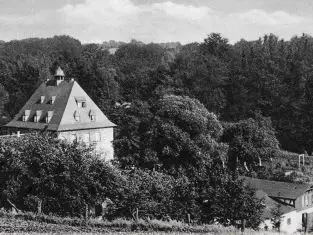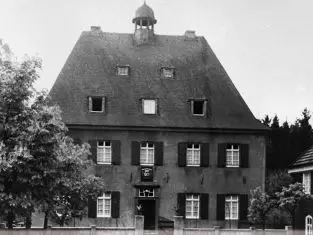The present listed house was built in the 18th century.
The name is borrowed from a forest above the house, which was once called "Der lange Scheid". The first owners of the knight's seat adorned themselves with the surname Langenscheid or Langscheid, which later developed into Landscheid. The original building was possibly built on a moth and surrounded by a moat. Parts of a medieval water pipe system have been found: hand-turned pipes made of light clay which led from two spring wells outside the house to a cistern in the cellar area.

On August 13, 1301 the history of Landscheid begins: Rolando and his brother Joanne called zu Langenscheid appear as contract witnesses at the purchase of the farm Bechen by the abbey Altenberg.
In 1402 Heinrich Flecke von Nesselrode, one of the most important families of the Bergisch nobility, became the owner.
In 1447/48 the brothers Johann Flecke von Nesselrode and Wilhelm, gen. "Herr zu Langescheid" are mentioned one after the other. They have gone down in legend as the "hostile brothers", one is said to have sawed off the other's head with a wood saw in a quarrel.
In 1576 after inheritance disputes, Landscheid with several farms, the Lambertsmühle and rents in kind ("Hoener, Botter, eggs, money and penny pensions") fell to Degenhardt von Hall.
In 1615 the daughter of Degenhardt von Hall marries Adolf Wolff gen. Metternich zur Gracht at Strauweiler Castle; Landscheid is now farmed by a half-man.
In 1626 Metternich has the "Lagh- und Mahlsteine" (lagstones and millstones) newly set to mark out his property and has a register of the condition of his estates drawn up.
In 1644 Metternich sells to Johann Degenhardt von Hall zu Ophoven. In 1712 the property goes to his grandson Bertram von Hall.
In 1712 the property goes to his grandson Bertram von Hall.
Between 1718 and 1725, Bertram von Hall built the baroque building, now a listed building, as a moated castle.
He had his coat of arms and that of his wife von Hochstetten placed in a cartouche with Latin inscription above the entrance. He builds a chapel for himself and his family. However, he got into debt not only because of the costly construction, but also because of lost hunting trials, sold several farms and pledged the house to his lender Heinrich von Monschau from Cologne
In 1764 Heinrich von Monschau from Cologne acquires the Landscheid estate.
In 1773 the daughter of Henry of Monschau sold Landscheid in 1773 to two owners, one half each. Even after several changes of ownership, the division remains.
In 1843 Carl and Gustav Liesendahl live in the western side set up a dyeing works on the banks of the Wiehbach (operated until 1907/08). In 1864 the interior of the house and the forecourt are separated by a wall.
In 1864 the interior of the house and the forecourt are separated by a wall.

In1912/13 Karl von Reden reunites both halves of the house and removes the dividing wall. After a roof truss fire Moses acquires gen. Moritz Franken from Cologne acquires the house and raises the roof truss higher than before.
In 1925 Karl von Reden sells the house to Vincenz-Verein-Jugendfürsorge GmbH, a supporting organisation of the Archbishopric of Cologne.
From 1929, the insurance salesman Robert Busch transforms the house into an upper middle-class villa. Following old plans, he restored the hall with the oak beam ceiling and changed the remaining rooms with great skill and a sense of history.
In 1952 after the death of Robert Busch the Düsselthal Rescue Centre in Wittlaer (today Rheinische Gesellschaft für Innere Mission und Hilfswerk GmbH) acquires the house
In 1953 founds the "Neu-Overdyk" boarding school for refugee boys between the ages of 10 and 18.
Between 1961-1969 Haus Landscheid is rented by Farbenfabriken BAYER as a home for single foreign women.
In 1968 the architect Gerbert Schlömer takes over the property, converts it into a hotel and adds a lower situated gourmet restaurant on the east side. After his sudden death in 1981, the owners changed several times.
In 1981 after the sudden death of Gerbert Schlömer, the owners changed several times.
In 1982 Landscheid was entered in the list of monuments. The farm building to the west of the main house is separated from the other buildings by separate sale and used as a farm. Afterwards, a new attempt is made to establish the house as a seminar hotel, but ultimately fails.
In 1999 Kurt Lammert bought the property left to decay at an auction to establish a branch of the Wersbach Clinic. Due to various unbridgeable regulations, the planned clinic could not be realized. Haus Landscheid was up for sale again.

At the end of 2008 Kurt Lammert decided to turn the former knight's seat into an exclusive gastronomy object.
The constellation of conference hotel, gastronomy, hotel business with wedding room, the Institute for Performance Optimisation ILO and the day clinic of the Wersbach Clinic is enjoying increasing popularity.
After a long period of threatening decay, the estate has had a promising future again since September 2010, and is now called "Gut Landscheid".
At this point we would like to thank our loyal customers and our employees!..